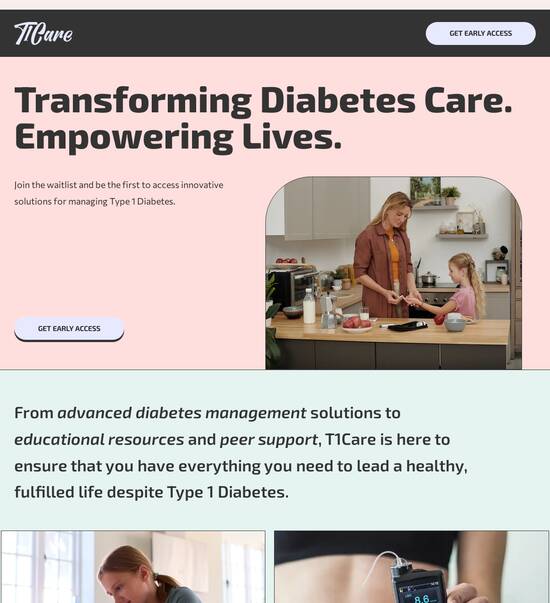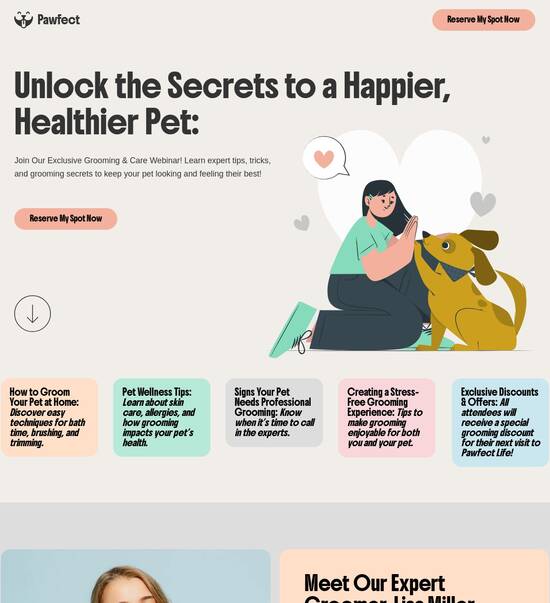
404 error page template optimized for iPhone
Explore Similar TemplatesAbout template
Design using a responsive 404 error page template that delivers a flawless experience on iPhone. Try Instapage today!
Recommended templates

Easy to build without coding
With the intuitive drag-and-drop builder, anyone on your team can create high-converting pages without any knowledge of code or design. Make enhancements to your landing page with custom widgets using Javascript, HTML/CSS, or third-party scripts.

Multiple layouts for any industry and goal
Select from 500+ landing page layouts built to boost conversions across industry-specific scenarios. Customize them by adjusting fonts, adding images, and generating on-brand content with the AI assistant. Quickly scale with Instablocks® and Global Blocks that you can save, reuse, and update globally.

Loads fast and looks polished on any device
Every template is responsive, which means they present professionally on any device and load blazingly fast with our Thor Render Engine. You can also power them up with Google AMP technology to deliver an unparalleled mobile experience and drive higher conversions.

Robust analytics & experimentation
Get real-time updates and reporting across all your devices, showing the number of visitors, conversions, cost-per-visitor, and cost-per-lead. Launch AI-powered experiments, run A/B tests, and use heatmaps to analyze user behavior, then optimize your landing page to maximize conversions.







Easy to build without coding
With the intuitive drag-and-drop builder, anyone on your team can create high-converting pages without any knowledge of code or design. Make enhancements to your landing page with custom widgets using Javascript, HTML/CSS, or third-party scripts.
Multiple layouts for any industry and goal
Select from 500+ landing page layouts built to boost conversions across industry-specific scenarios. Customize them by adjusting fonts, adding images, and generating on-brand content with the AI assistant. Quickly scale with Instablocks® and Global Blocks that you can save, reuse, and update globally.
Loads fast and looks polished on any device
Every template is responsive, which means they present professionally on any device and load blazingly fast with our Thor Render Engine.
Robust analytics & experimentation
Get real-time updates and reporting across all your devices, showing the number of visitors, conversions, cost-per-visitor, and cost-per-lead. Launch AI-powered experiments, run A/B tests, and use heatmaps to analyze user behavior, then optimize your landing page to maximize conversions.
All the features you need to build iphone message template
Explore more featuresLearn how to build top-performing landing pages for any goal
FAQs
Leading the way in building high-performing landing pages





Creating an effective landing page using Instapage
Instapage is a powerful tool designed to help marketers create high-converting landing pages. If you're looking to optimize your digital marketing campaigns and maximize ROI, this step-by-step guide will walk you through the process of leveraging Instapage's capabilities to build compelling landing pages that capture leads and engage your target audience.
Understanding Instapage features
Before diving into the building process, it's crucial to understand the key features of Instapage. The platform offers access to numerous templates, a flexible page builder, and a suite of optimization tools. Each feature is designed to streamline the process of creating and refining landing pages, ensuring marketers can deliver tailored experiences efficiently.
- High-converting templates: Instapage provides over 100 ready-to-use landing page templates that cater to various industries. These templates are optimized for conversions and can save you significant time.
- Intuitive page builder: With a drag-and-drop interface, building landing pages becomes a straightforward task, eliminating the need for extensive coding or development skills.
- Optimization tools: Instapage offers A/B testing and heatmaps to help you identify user behavior on your pages, making it easier to make data-backed improvements.
Step 1: Selecting the right template
Choosing an appropriate template can set the foundation for a successful landing page. Start by identifying your campaign goals and target audience. Instapage's library allows you to filter templates by industry, ensuring that your design aligns closely with your specific needs.
Step 2: Customizing your landing page
Once you've selected a template, it's time to customize it to reflect your brand’s identity. Utilize the drag-and-drop builder to add elements that resonate with your target audience, and don't forget to utilize dynamic text replacement for personalization.
- Brand colors and logo: Consistency with your branding will enhance recognition and build trust with your audience.
- Calls-to-action (CTAs): Make sure your CTAs are clear and compelling; they should encourage visitors to take immediate action.
- Images and multimedia: Incorporating relevant images and videos can significantly impact engagement rates.
Step 3: Optimizing for conversions
Once your landing page looks great, the next step is ensuring it's optimized for conversions. Use Instapage's A/B testing features to compare different versions of your page, and employ analytics tools to track user behavior.
- A/B testing: Test different headlines or CTAs to see which performs best in terms of conversion rates.
- Heatmap analysis: Understanding where visitors are clicking can inform layout adjustments and improve user experience.
- Loading speed: Ensure your landing page loads quickly to reduce bounce rates and keep users engaged.
The journey from template selection to optimization is vital for maximizing your marketing efforts with Instapage. By strategically leveraging its features, you can create captivating landing pages that convert.
Ready to take your landing pages to the next level? Sign up for Instapage today and start transforming your digital marketing campaigns.
People also ask about 404 error page template optimized for iPhone
404 error page template optimized for iPhone
Understanding the 404 error page: A necessary feature for every iPhone user
When a user attempts to access a webpage that is no longer available or does not exist, they are met with a 404 error page. This page serves as an essential part of the user's journey, especially on mobile devices like the iPhone, where experience and efficiency are paramount. Unlike traditional desktop experiences, iPhone users expect seamless navigation that meets their instant gratification needs.
404 errors can significantly impact user experience and perception of a website. The design and messaging of a 404 error page can either frustrate users or guide them back to valuable content. Statistics indicate that nearly 68% of users who encounter a 404 error leave the website entirely, thereby elevating the bounce rate and potentially losing new or returning customers.
The importance of a 404 error page
A well-crafted 404 error page isn't just a placeholder; it's an opportunity to maintain engagement with users. Mobile users, especially iPhone users, have specific expectations regarding design and clarity. A lack of an effective 404 page can lead to negative perceptions of a brand. By acknowledging the presence of an error and providing clear guidance on how to continue navigating the site, businesses can mitigate potential damage to their reputation.
Furthermore, bounce rates tend to skyrocket following a 404 error, underscoring the importance of this function. When users land on a 404 page, they are more likely to abandon the site altogether if they do not find clear next steps. This makes it imperative for websites to prioritize the design of their error pages.
What makes an effective 404 error page?
An effective 404 error page should embody several key elements to enhance user experience. First, it should look visually appealing on iPhone screens. Proper dimensioning ensures that the design takes full advantage of the iPhone's retina display, maintaining crisp visuals without compromising load times.
Second, the wording needs to be clear and relatable. Users should immediately understand they’ve hit a snag along their browsing journey. For better guidance, the page should offer navigation options, perhaps through easily accessible links to the home page or popular sections. Additionally, linking to an internal search bar can help users find what they’re looking for without backtracking through numerous pages.
Visually appealing aesthetics tailored for iPhone screens
Clear messaging that resonates with users’ experiences
Navigation options to guide users back to relevant content
Optimizing your 404 error page for iPhone users
Optimizing your 404 error page requires adhering to mobile-first design principles, purely because iPhone users access websites differently than desktop users. Responsive design is critical, ensuring that all elements of the 404 page adapt smoothly to various screen sizes. This process involves selecting the appropriate font sizes and ensuring buttons are large enough to be easily tapped, avoiding any user frustration.
Understanding touch targets is crucial as well; buttons and links should be easily clickable without needing precision. Additionally, leveraging iPhone features, like swipe gestures, can offer users interactive pathways to navigate away from the error page. Implementing these considerations means users are more likely to continue exploring your website rather than leaving during a frustrating encounter.
Using notifications to enhance user experience
Notifications can play a vital role in transforming an error experience into a guided journey. In-page notifications can prompt users to take action while they’re still on the 404 page. Suggestions can include returning to the homepage or exploring trending content, turning initial frustration into constructive navigation.
Additionally, push notifications can be strategically used to reinforce brand communication well after the encounter. Understanding user behavior enhances the relevance of these messages, making them more likely to engage. Designing notifications with consideration for user interaction can significantly improve overall user experience.
In-page notifications prompting further action
Push notifications reinforcing brand communication
Transforming frustration into opportunity
Instead of viewing a 404 error page solely as a setback, businesses can harness this opportunity for revenue generation. Integrating promotional content, such as discounts or featured products, can turn a negative experience into a positive interaction. Engaging messages that encourage newsletter subscriptions can also increase user retention in the long run.
Brands have successfully transformed their error pages into marketing platforms. For example, including catchy taglines or humor in their messaging has resulted in increased user engagement and a more favorable perception of the brand overall.
Integrating promotional content like discounts or featured items
Encouraging newsletter subscriptions with engaging messages
The use of popups and interactivity
Implementing interactive elements on 404 error pages can enrich the user experience, encouraging visitors to explore more. Engaging popups, for instance, can offer users suggestions based on their browsing history or areas of interest. This can act as a useful nudge to keep users engaged when they might otherwise leave.
Incorporating gamification elements can also transform the frustration experienced on a 404 page. Fun quizzes or simple interactive challenges could lead to a stronger connection with the brand. Leveraging interactivity not only beautifies the error page but also increases the likelihood of users returning, thereby enhancing overall user retention.
Designing for diverse audiences
Understanding the diverse audiences accessing your site through an iPhone is crucial. Targeted messaging can significantly improve user experience on a 404 error page. Customizing content based on audience segments, such as potential subscribers or first-time visitors, ensures the right prompts are delivered effectively.
Additionally, optimizing for accessibility helps include all user groups. Designing error pages to be navigable for users with disabilities plays a pivotal role in demonstrating inclusivity, thus enhancing overall brand image across multiple demographics.
Analyzing 404 page performance
It’s important to measure the performance of your 404 error page for continuous improvement. Key metrics, such as user interaction rates and navigation paths following an error encounter, provide actionable insights. Utilizing these metrics offers a clear view of user behavior and helps identify how effectively the page guides users back to valuable content.
A/B testing different designs or messages can further enhance understanding of what resonates with users. Gathering feedback from user interactions can yield rich data that informs future iterations.
Tracking user interactions and navigation paths post-error
Analyzing conversion rates before and after implementing optimizations
Case studies: Successful implementation of 404 error pages
Several brands have successfully leveraged optimized 404 error pages to engage users effectively. For instance, a well-known e-commerce site redesigned its 404 page to include an interactive search tool along with a fun error-themed quiz, resulting in a 37% decrease in bounce rates from 404 encounters.
These case studies demonstrate how an effective error page can work not just as a stop-gap but as a powerful tool for engaging users and enhancing brand loyalty. The financial implications are just as significant; businesses often report increased sales conversions following an optimized error page launch.
Future trends in 404 error page optimization
The future of 404 error pages looks promising, with evolving user preferences demanding more tailored mobile experiences. We can expect the integration of artificial intelligence and chatbots to assist users in real-time on 404 pages, providing instantaneous answers or directing users back to relevant content.
Moreover, as technology advances, new design innovations will emerge that redefine how users engage with error pages. Brands need to stay abreast of these trends to ensure they provide experiences that not only meet but exceed users’ expectations.
Ready to skyrocket conversions?
Supercharge your ad campaigns with high-performing landing pages
Get started














